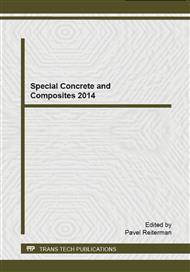p.64
p.71
p.75
p.80
p.85
p.90
p.95
p.99
p.104
The Possibilities of Application of Cellulose Fibers in Cement Composites, Monitoring the Properties
Abstract:
Application of cellulose fibers in cement composites is one of the possibilities for achieving better utility properties of these composites. This article presents findings of experimental works concerned on increasing the resistance of cement composites to high temperatures. Properties of cement composites with the addition of cellulose fibers Greencel were observed. Rheological properties of fresh composite, mechanical properties and changes of properties after heat load were evaluated. The best mechanical properties showed the samples with technical cellulose, namely with the fiber G-55T and G-700T. The process of cellulose fiber degradation at high temperatures was documented. The process of carbonization of cellulose fibers leads to the creation of pore system, which enables to increase the resistance of cement composites to high temperatures.
Info:
Periodical:
Pages:
85-89
Citation:
Online since:
October 2014
Authors:
Price:
Сopyright:
© 2014 Trans Tech Publications Ltd. All Rights Reserved
Share:
Citation:


